Worried about injuries or poor performance on artificial grass? The wrong shoes can cause slips and joint pain. I will show you how to choose the right pair for safety.
For most modern artificial grass fields, shoes with "AG" (Artificial Grass) soles are best. They have shorter, hollowed-out studs that provide excellent grip without damaging the turf or your joints.
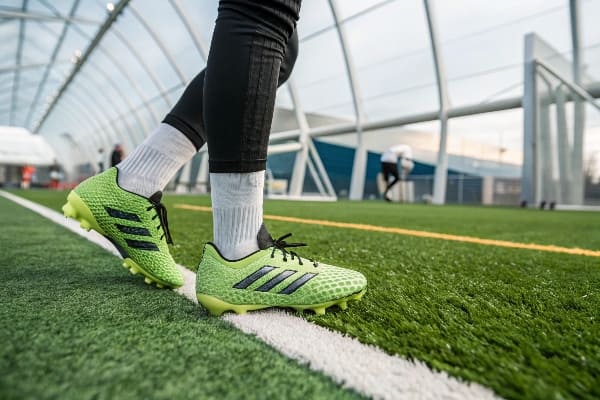
Choosing the right shoe is more than just looking for an "AG" label. The type of artificial grass makes a big difference. Understanding these differences is the first step to making the best choice. Let’s explore why artificial grass requires special attention and what makes it different from natural grass.
How Are Natural and Artificial Grass Pitches Different for Players?
Think all green fields are the same? Playing on artificial turf feels very different from natural grass, and wearing the wrong shoes can make you feel clumsy and increase your risk of injury.
Artificial grass is firmer and has more grip than natural grass. This means soccer balls move faster, and your feet can get "stuck" if you wear long studs. Natural grass is softer, providing more cushion.
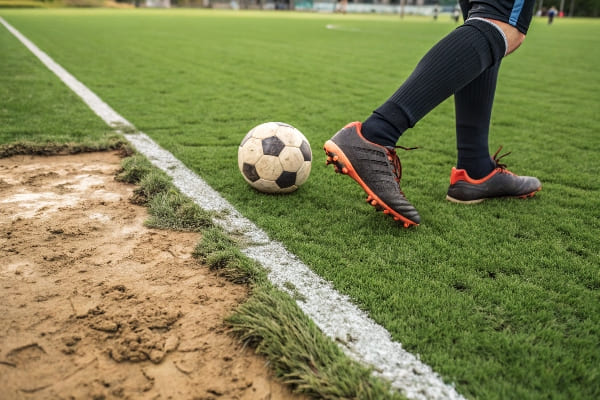
I remember when my company first installed a high-quality 3G pitch for a client. The players were excited, but after the first few games, some complained about sore knees and ankles. They were all using their old Firm Ground (FG) cleats1. Their feet were gripping the surface too aggressively. This taught me a valuable lesson about educating people on proper footwear. It’s not just about protecting the turf; it is about protecting the players. The interaction between the player’s shoe and the surface is everything.
Surface Hardness and Impact
Natural grass grows from soil, which has a natural give. Artificial turf is laid over a shock-absorbing pad and base, but the surface itself is less forgiving. This means more impact goes back into a player’s joints, like their ankles and knees. The right shoes, especially those with good cushioning, help to reduce this impact.
Friction and Grip2
Artificial turf creates more friction than natural grass. This affects how the ball rolls and how your shoes interact with the ground. Firm-ground cleats with long studs are designed to dig into soil for grip. On artificial turf, they can dig in too deep. This creates a dangerous "sticking" effect that can lead to serious injuries.
| Feature | Natural Grass | Artificial Grass |
|---|---|---|
| Shock Absorption | High (depends on soil moisture) | Moderate to High (depends on pad) |
| Grip Level | Variable (weather-dependent) | High and Consistent |
| Surface Firmness | Soft | Firm |
| Heat Retention | Low | High |
What Are the Key Factors in Choosing Artificial Turf Shoes?
Feeling overwhelmed by all the shoe options? There are so many types, materials, and stud patterns. Choosing incorrectly can lead to discomfort, poor performance, and even voiding the turf’s warranty.
Focus on the outsole (stud pattern), midsole (cushioning), and upper material. The stud pattern is most critical for grip and safety. AG or Turf (TF) soles are ideal. Good cushioning protects your joints.
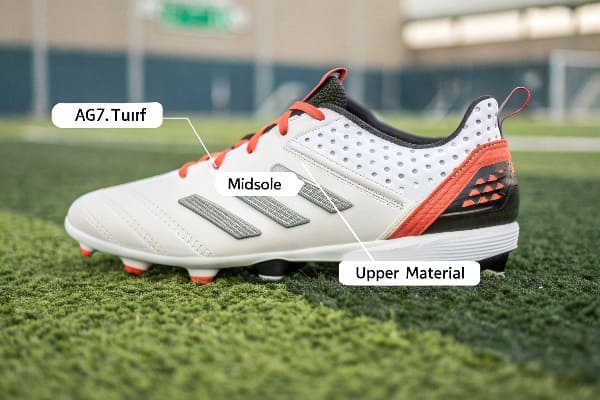
When I help clients choose artificial turf for their projects, I always include a small guide on footwear. It’s a detail that shows we care about the end-user experience. A business owner who installs a pitch wants people to love playing on it. The right shoes are a huge part of that. Let’s break down the key parts of the shoe.
The Outsole: Studs and Traction
The outsole is the bottom of the shoe that touches the ground. This is the most important feature for artificial turf. The length, shape, and pattern of the studs determine your grip and safety. Using the wrong studs is not only dangerous for you but can also damage the turf fibers and backing, which could void the warranty on a new field.
The Midsole: Cushioning is Key
The midsole provides cushioning. Because artificial grass is harder than natural grass, a cushioned midsole is very important. It absorbs shock and reduces the strain on your feet, ankles, and knees. Look for shoes with EVA foam or other cushioning technologies to provide that extra comfort and protection during a long match.
The Upper: Material and Fit
The upper is the part of the shoe that covers your foot. It can be made from leather, synthetic leather, or knit materials. The best choice here is about personal preference for fit and feel. A synthetic upper is often lighter and more durable, while leather can offer a more molded, comfortable fit over time.
| Stud Type | Best Surface | Description |
|---|---|---|
| AG (Artificial Grass) | Modern 3G/4G Artificial Grass | Shorter, hollow, conical studs. Disperses pressure evenly. |
| TF (Turf) | Older "Astroturf" / Carpet-style Turf | Many small rubber nubs. Great for training and on hard ground. |
| FG (Firm Ground) | Natural Grass | Long, bladed, or conical studs. Unsafe for AG. |
| IN (Indoor) | Hard Indoor Courts | Flat, non-marking rubber sole. No studs. |
Are Regular Turf Shoes (TF) Good for Modern Artificial Grass Pitches?
You see "turf shoes" and think they are perfect for all artificial turf, right? It can be confusing. Using the wrong type can leave you slipping on longer-pile turf and reduce your stability.
Traditional Turf (TF) shoes with many small rubber nubs are best for older, shorter-pile "carpet-style" turf. For modern 3G or 4G artificial grass with rubber infill, AG shoes3 are superior.
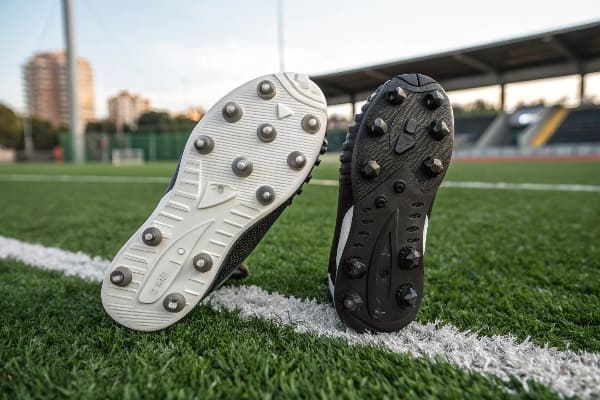
Not all artificial turf is the same. The technology has evolved a lot over the years. I often have to explain this to clients who are upgrading their old fields. They need to understand that a new surface requires new thinking about footwear.
Understanding Turf Generations
Artificial grass is often described in "generations."
- 1G Turf: This is the old-school, carpet-like turf, often called "astroturf." It has a very short pile and is often just laid over concrete. TF shoes4 are perfect for this.
- 2G Turf: This generation added sand infill to a slightly longer pile. It offered more stability. TF shoes4 still work well here.
- 3G Turf: This is the most common type today for soccer. It has a long pile (40-60mm) with both sand and rubber crumb infill. This surface mimics natural grass better but requires more grip than TF shoes4 can offer. This is where AG shoes3 are essential.
- 4G Turf: This is a newer type that uses a very dense, long pile to try and eliminate the need for rubber infill. AG shoes3 are still the best and safest choice here.
TF shoes4 do not have studs that can penetrate the surface of a 3G pitch. This means you will be playing on top of the rubber infill, which can feel slippery. AG shoes3 have studs that are long enough to grip the turf matting between the infill, giving you much better traction.
What Are the Best Overall Shoe Types for Artificial Grass?
So many details to remember. You just want a clear, final recommendation. Getting lost in the details can lead to making no decision, or worse, the wrong one.
The best all-around choice is the AG (Artificial Grass) shoe. It offers the perfect balance of grip, safety, and comfort for modern pitches. For older turf or training, the TF shoe is a great option.
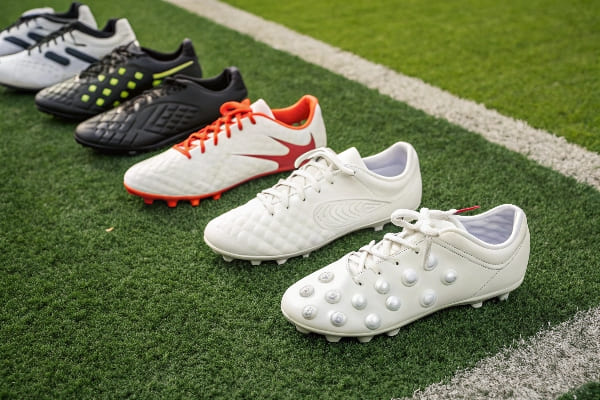
If I had to give one piece of advice to a player or a facility manager, it would be this: invest in AG shoes3. They are designed specifically for the environment of a modern artificial pitch. It is a simple step that improves player safety and protects the field itself. When a customer buys a field from us, part of my job is to ensure they get the most value from it for years to come. Advising on correct footwear is a key part of that long-term value.
Your Go-To Choice: AG Cleats
These are the specialists. Their hollow, conical studs distribute pressure evenly across your foot. This reduces the risk of pain. The stud length is perfect for gripping a 3G or 4G surface without getting stuck.
The Reliable Alternative: TF Shoes
These are the versatile workhorses. With their many tiny rubber nubs, they are very stable and comfortable on hard surfaces. They are great for training, warming up, or playing on older 1G or 2G turf fields.
Shoes to Avoid at All Costs
Never, ever wear Firm Ground (FG) or Soft Ground (SG) cleats on artificial turf. The long studs can cause serious knee and ankle injuries. They also can rip and tear the turf backing, causing permanent damage and voiding the field’s warranty.
| Shoe Type | Best For | Why? | Risk Level |
|---|---|---|---|
| AG | Modern (3G/4G) artificial grass | Optimal grip, pressure distribution, player safety. | Low |
| TF | Old (1G/2G) turf, training | Excellent stability, low impact, durable. Good for hard ground. | Low |
| FG | Natural grass ONLY | Studs are too long. High risk of joint injury and turf damage. | High |
| SG | Soft, wet natural grass ONLY | Metal-tipped studs. Extremely dangerous on AG. Voids warranty. | Very High |
Any Final Tips for Using Soccer Shoes on Artificial Grass?
You’ve chosen your shoes, but want to make sure you get the most out of them. Small mistakes in maintenance or usage can shorten your shoes’ life and reduce your performance.
Always clean your shoes after use to remove infill. Check for stud wear regularly, as worn-down studs lose grip. Also, consider shoes with good ventilation, as artificial turf gets hot.
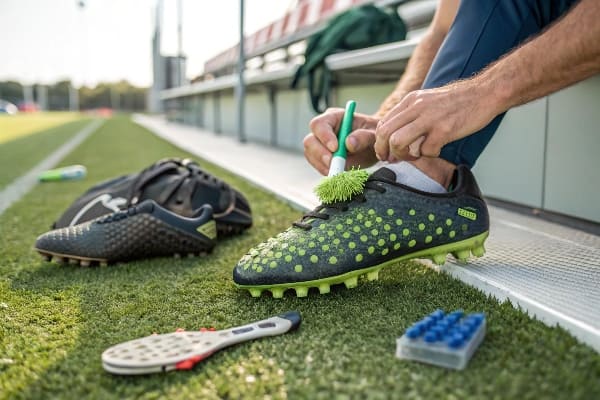
Taking care of your equipment is a sign of a serious player. I always keep my shoes clean, not just because it looks professional, but because it helps them last longer and perform better. I also keep both an AG and a TF pair in my sports bag. You never know what kind of field you will end up playing on, so it is always good to be prepared.
Tip 1: Clean Your Shoes After Every Game
Artificial turf pitches have sand and rubber infill that will get stuck in your shoes and on your studs. After each use, clap your shoes together, sole to sole, to knock out the loose debris. Use a soft brush to gently clean out any remaining bits. This keeps the studs effective and stops you from tracking infill everywhere.
Tip 2: Check for Wear and Tear
Regularly inspect the studs on your AG or TF shoes4. Over time, they will wear down from the abrasive nature of the turf. Worn-down studs offer less grip and can become a safety hazard. If the studs are noticeably shorter or have lost their shape, it is time for a new pair.
Tip 3: Prioritize Breathability and Fit
Artificial grass can get much hotter than natural grass on a sunny day. This heat transfers to your shoes and feet. Look for shoes with mesh panels or other breathable materials to help keep your feet cool and reduce sweat. A proper fit is also key to preventing blisters and discomfort.
Conclusion
Choosing the right soccer shoes for artificial grass is crucial for safety and performance. AG shoes are best for modern fields, while TF shoes work well for older or harder surfaces.
-
Understand the dangers of using FG cleats on artificial surfaces to avoid injuries and damage. ↩
-
Learn how friction impacts your movement and stability on the field, crucial for injury prevention. ↩
-
Explore the features of AG shoes that make them ideal for modern artificial turf, enhancing safety and performance. ↩ ↩ ↩ ↩ ↩
-
Discover the limitations of TF shoes on newer turf types to make informed footwear choices. ↩ ↩ ↩ ↩ ↩
_画板-1.png)
_画板-1.png)